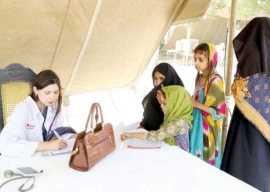
The study, titled National Complementary Feeding Assessment, was launched by the Ministry of National Health Services, Regulation and Coordination here on Wednesday.
As much as 78 per cent of the children had below optimal dietary diversity, and several nutrient-rich food groups are rarely consumed by infants under two years of age because of poverty and limited access to health and nutrition services.
The diet of children in this age group routinely lacks eggs, meat, vitamin A and iron-rich foods, while locally-available foods were mainly deficient of vitamin B12, vitamin A, calcium and iron.
Malnutrition major cause of fatalities among children
Inappropriate complementary feeding practices, along with breast or formula milk for children aged between six and 23 months, were a major cause of malnutrition and stunting, the study stated.
This study was conducted with the financial support of the United Kingdom’s Department for International Development (DFID) and the technical support of the United Nations Children’s Fund (UNICEF).
The assessment provides an in-depth analysis on the feeding practices, related barriers and boosters as well as guidance for improving these practices for children aged between six and 23 months.
According to the assessment, as much as 63 per cent of children in this age group received the minimum recommended number of meals per day and breastfeeding while 22 per cent had access to four of seven WHO-recommended food groups.
Just 15 per cent of the children in this age group received adequate number of meals with at least four necessary food groups.
Pakistani children, the report indicated, mostly consumed grains, roots, and tubers (81 per cent) while the consumption of legumes and nuts was lowest (six per cent). The consumption of dairy products was 60 per cent, vitamin A-rich foods 19 per cent, eggs 25 per cent and any kind of meat 18 per cent.
Pakistan’s malnutrition crisis
Consumption of foods rich in Vitamin A and iron was lower in stunted and underweight children, it stated.
According to the study, children who were not stunted consumed more dairy products (60%), other fruits and vegetables (40%), eggs (31%) and meat (20%) than stunted children (55%, 31%, 23%, and 17%, respectively).
Consumption of unhealthy packaged items and chips was also very common because parents thought them to be of nutritional value.
The study also found that the consumption of seven food groups increased with the increase in wealth quintiles.
The cost of a Nutritious Diet ranged between Rs104,000 and Rs171,300 annually per household. The cost of a Food Habit Nutritious Diet ranged between Rs144,900 and Rs212,200 annually per household.
Roundtable on nutrition: Rs10b funds to end stunting in children
It also found that dietary habits restricted the consumption of some nutritionally-rich and less expensive foods such as Maithi (fenugreek), Bajra (millet) and Jawar (sorghum).
Children, whose mothers were aged between 19 and 34 years, were 2.3 times more likely to have access to a diverse diet than children whose mothers were younger (aged between 15 and 18 years).
Educated parents, mothers’ role in decision making, access to mass media and living in a joint family also had positive impacts on diverse diets.
DfID’s Ruth Lawson and UNICEF’s Deputy Representative in Pakistan Cristian Munduate also spoke on this occasion.




1719660634-1/BeFunky-collage-nicole-(1)1719660634-1-165x106.webp)





1724249382-0/Untitled-(640-x-480-px)1724249382-0-270x192.webp)






COMMENTS
Comments are moderated and generally will be posted if they are on-topic and not abusive.
For more information, please see our Comments FAQ